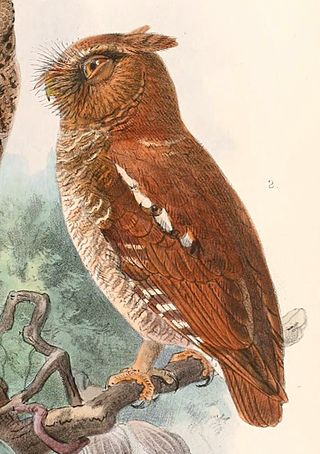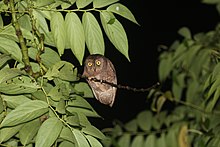
The collared scops owl is an owl which is a resident breeder in south Asia from northern Pakistan, northern India, Nepal, Bangladesh, the Himalayas east to southern China, and Taiwan. It is partially migratory, with some birds wintering in India, Sri Lanka and Malaysia. This species was formerly considered to be included within what is now separated as the Indian scops owl.

The Philippine scops owl, also Luzon lowland scops owl is a common owl, endemic to the Philippines, belonging to the family of the typical owls Strigidae. Other common names include "Otus Whitehead", "Whitehead scops owl" and "Luzon lowland scops owl". Everett's scops owl and Negros scops owls were formerly considered conspecific but are now classified as separate species.

The Siau scops owl is a critically endangered owl species. They live on Siau Island, north of Sulawesi, Indonesia and are (were) forest dwellers. The species is only known from a single holotype from 1866 although there have been more recent potential sightings, including one in 2017. Nonetheless, their already small, relatively barren habitat is being lost to excessive logging of the little forest present on the island and there are assumed to be very few individuals left, if any. The taxonomic arrangement for this owl has not been fully worked out. While recognized as a distinct species by the IOC, others consider it as a subspecies of either the Sulawesi scops owl or Moluccan scops owl, and it has recently been analyzed and found to be closest in morphology to Sangihe scops owl.

The pallid scops owl is a small scops owl ranging from the Middle East to west and central Asia, sometimes called the striated scops owl.

The white-fronted scops owl is a small Asian owl in the family Strigidae. It has a declining population about which little is known, and is dependent on lowland and foothill forests which are rapidly being destroyed. This species of owl is considered vulnerable and has a population of about 2,500–10,000. It is found in west of Thailand and also in peninsular Malaysia. Its range covers 149,000 km2 (58,000 sq mi) of forest at altitudes of 0–700 m (0–2,300 ft) above sea-level.

The sandy scops owl, or cinnamon scops owl, is an owl from the family Strigidae found in Africa.

The Flores scops owl is an owl endemic to the island of Flores, Indonesia. It is threatened by habitat loss. This owl is around 19–21 cm from head to tail. They are a forest dwelling owl that is smallish in size. Some 250–2,499 individuals are estimated to be extant in the wild, dwindling due to habitat loss.

The mountain scops owl, sometimes referred to as the spotted scops owl, is a species of owl in the family Strigidae. It is locally common in its main habitat which covers some parts of Asia, including Bangladesh Bhutan, Pakistan, India, Malaysia, Nepal, Taiwan, and Thailand. It is an altitudinal migrant. It has a short high-pitched call. Their call sounds like a two-note whistle, "plew-plew" or "he-he", although the female's songs are rarely heard. Their calls can also vary between different populations allowing one to determine a bird's origin.
The Javan scops owl is a small species of owl living mainly on western Java's high volcanos; local people refer to the owl as Celepuk Jawa. Like most owls, this nocturnal bird also has a strong ability of silent flight.
The Mentawai scops owl is endemic to larger islands of Mentawai, off west Sumatra, Indonesia.

The Sunda scops owl is a small brown owl native to the Sunda Islands.

The Palawan scops owl is an owl endemic to the Philippines only being found on the island of Palawan. It is found on tropical moist lowland forest. It is threatened by habitat loss.

The Mindanao scops owl or Mindanao highland scops owl is an owl endemic to Mindanao island in the Philippines. It is found in tropical montane forest above 1,000 meters above sea level. It is threatened by habitat destruction and deforestation.

The Luzon scops owl or the Luzon highland scops owl is a species of scops owl endemic to Luzon, Philippines. Not to be confused with the Philippine scops owl, sometimes referred to as the Luzon lowland scops owl, which is a more common species that shares the same range. The Luzon scops owl, however, is smaller and inhabits higher altitudes than its lowland relative.

The Sulawesi scops owl is an owl found on the Sulawesi island of Indonesia.
The Enggano scops owl is an owl endemic to Enggano Island, Indonesia.

The giant scops owl, lesser eagle owl, Mindanao eagle owl or Mindanao owl, is a species of owl in the family Strigidae. It is endemic to the Philippines found on the islands of Mindanao, Dinagat Islands, Siargao and was only discovered in Samar in 2010. In size and structure, it is considered intermediate between a scops owl and an eagle-owl. Its natural habitat is tropical moist lowland forests. It is threatened by habitat loss.

The Mayotte scops owl is a species of owl in the family Strigidae. It is endemic to the island of Mayotte in the Comoros.

The Pemba scops owl is a species of owl in the family Strigidae. It is endemic to Pemba Island which is part of and off the coast of Tanzania.

Everett's scops owl is an owl, endemic to the Philippines, belonging to the family of the typical owls Strigidae. They are found on Bohol, Samar, Biliran, Leyte, Mindanao and Basilan. This species is part of the Philippine scops owl species complex which includes the Negros scops owl.


















